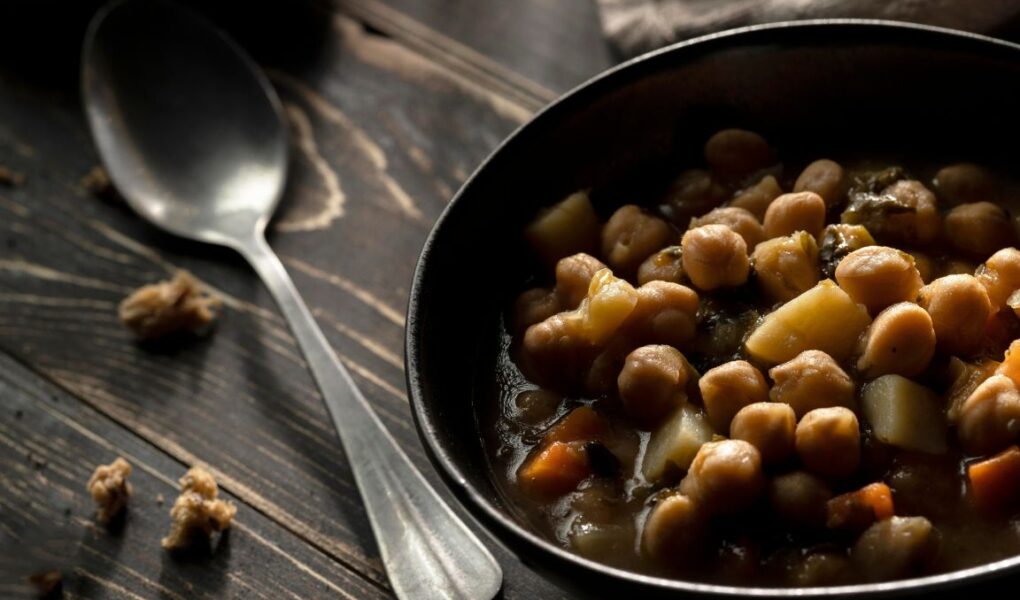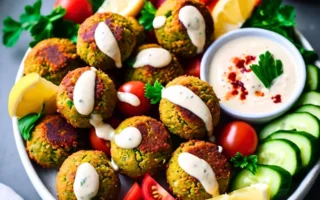Wanted to know the recipe for a delicious Vegan Chickpea Curry Recipe?
We love the vegan recipes that include chickpeas and curry as it is vegan friendly and a super nutritious meal. Here you’ll learn all about this delicious and nutritious vegan meal.
How many people is this receipt for?
The Vegan Chickpea Curry recipe provided is a general guideline and the number of servings may vary depending on individual portion sizes and dietary requirements. However, as a rough guide, the recipe is designed to serve about 4 people. Adjustments can be made to suit your specific requirements:
If you’re serving the curry as a main course with rice or other side dishes, it should comfortably serve 4 people.
If you’re serving it as a side dish or as part of a larger meal, it can serve more people.
Feel free to adjust the quantities of ingredients to suit your taste and the number of people you’re serving. You can also easily double or halve the recipe to suit your needs.
Ingredients
- 2 cans (15 oz each) chickpeas, drained and rinsed
- 1 large onion, finely chopped
- 3 cloves garlic, minced
- 1 inch ginger, grated
- 1 can (14 oz) diced tomatoes
- 1 can (14 oz) coconut milk
- 1 tablespoon curry powder
- 1 teaspoon ground cumin
- 1 teaspoon ground coriander
- 1/2 teaspoon turmeric
- 1/4 teaspoon cayenne pepper (adjust to taste for spice level)
- Salt and pepper to taste
- 2 tablespoons vegetable oil
- Fresh cilantro, chopped (for garnish)
- Cooked rice or naan (for serving)
Instructions
- Prepare Ingredients:
- Drain and rinse the chickpeas.
- Finely chop the onion, mince the garlic, and grate the ginger.
- Open the cans of diced tomatoes and coconut milk.
- Sauté Aromatics:
- Heat vegetable oil in a large pan over medium heat.
- Add chopped onions and sauté for 5-7 minutes until they become translucent and start to brown.
- Add minced garlic and grated ginger. Sauté for another 1-2 minutes until fragrant.
- Add Spices:
- Add curry powder, ground cumin, ground coriander, turmeric, and cayenne pepper to the pan. Stir well to coat the onions in the spices. Cook for 1-2 minutes to allow the spices to bloom.
- Combine Ingredients:
- Pour in the diced tomatoes with their juice. Stir to combine with the spices and cook for 5 minutes until the tomatoes break down and the mixture thickens slightly.
- Add Chickpeas:
- Add the drained and rinsed chickpeas to the pan. Stir to coat them in the tomato and spice mixture. Allow the chickpeas to absorb the flavors for a few minutes.
- Pour in Coconut Milk:
- Pour in the coconut milk, stirring well to combine. Bring the mixture to a simmer, then reduce the heat to low and let it simmer for 15-20 minutes, allowing the flavors to meld together. Stir occasionally.
- Season and Garnish:
- Season with salt and pepper to taste. Adjust the spice level if needed.
- Garnish with chopped fresh cilantro just before serving.
- Serve:
- Serve the vegan chickpea curry over cooked rice or with naan bread.
How Many Calories Contain?
The calorie content of the Vegan Chickpea Curry can vary based on specific ingredients and serving sizes. However, I can provide you with a general estimate based on the ingredients listed in the recipe. Keep in mind that this is an approximate value and actual calorie content may vary.
Here’s a rough estimate for one serving (without rice or naan):
- Calories per serving: Approximately 350-400 calories
This estimate includes the chickpeas, coconut milk, vegetables, and spices. If you’re looking for a more accurate calorie count, you may want to use a nutrition calculator or consult specific product labels for precise information, especially if you make any modifications to the recipe. Additionally, the calorie content will increase if you serve the curry with rice or naan, so be sure to account for those calories as well. Also, This dish pairs perfectly with our Vegan Garlic Roasted Broccoli as a side.
What’s about the nutritional details?
Here’s an approximate breakdown of the nutritional details for one serving of Vegan Chickpea Curry (without rice or naan). Keep in mind that these values are rough estimates and can vary based on specific ingredients and serving sizes:
Nutritional Information (per serving):
- Calories: 350-400 kcal
- Protein: 10-12g
- Fat: 20-25g
- Saturated Fat: 15g
- Carbohydrates: 30-35g
- Fiber: 7-9g
- Sugars: 6-8g
- Sodium: 600-800mg (may vary based on added salt)
- Vitamin A: 10-15% DV
- Vitamin C: 20-25% DV
- Calcium: 8-10% DV
- Iron: 20-25% DV
These values are based on the general composition of chickpeas, coconut milk, and the other ingredients used in the recipe. If you have specific dietary concerns or requirements, it’s advisable to use a nutrition calculator or consult with a registered dietitian for more precise information, especially if you make any modifications to the recipe. Additionally, the nutritional content may change if you include rice or naan with your meal.
What’s about the healthy benefits?
Vegan Chickpea Curry offers various health benefits due to its nutrient-rich ingredients. Here are some potential health benefits associated with this dish:
- Rich in Protein: Chickpeas are an excellent plant-based source of protein. Protein is essential for muscle repair, immune function, and overall cellular health.
- High in Fiber: Chickpeas are high in dietary fiber, which aids in digestion, promotes a feeling of fullness, and helps regulate blood sugar levels. Fiber is also beneficial for heart health.
- Loaded with Vitamins and Minerals: The curry’s ingredients, such as tomatoes, onions, and spices, contribute essential vitamins and minerals. For example, tomatoes provide vitamin C, potassium, and antioxidants.
- Healthy Fats: Coconut milk, used in this recipe, provides healthy fats, including medium-chain triglycerides (MCTs). These fats are known for their potential benefits for heart health and metabolism.
- Anti-Inflammatory Properties: Many of the spices in the curry, such as turmeric and ginger, have anti-inflammatory properties. Curcumin, found in turmeric, is known for its potential anti-inflammatory and antioxidant effects.
- Supports Blood Sugar Control: The combination of chickpeas, vegetables, and spices can contribute to better blood sugar control, particularly due to their high fiber content.
- May Aid Weight Management: High-fiber and protein-rich meals can contribute to a feeling of fullness, potentially supporting weight management by reducing overall calorie intake.
- Heart Health: The combination of plant-based ingredients, including chickpeas and coconut milk, may contribute to heart health by positively influencing cholesterol levels and blood pressure.
It’s important to note that the health benefits depend on the overall context of your diet and lifestyle. While this Vegan Chickpea Curry can be a nutritious and flavorful dish, it’s part of a broader, balanced diet that promotes overall health. Additionally, individual dietary needs and preferences may vary, so it’s advisable to consult with a healthcare professional or registered dietitian for personalized nutrition advice.
Alright, a little history of this meal
The story behind a recipe can be as diverse as the people who create and enjoy it. While there may not be a specific historical or cultural story attached to the Vegan Chickpea Curry recipe provided, the idea of chickpea-based dishes has roots in various cuisines around the world.
Chickpeas, also known as garbanzo beans, have been cultivated for thousands of years and are a staple ingredient in many traditional dishes. In Indian cuisine, for example, chickpeas are frequently used in curries, and they are a key component in dishes like Chana Masala. Coconut milk is often used in South Asian and Southeast Asian cuisines, adding richness and flavor to many dishes.
The fusion of chickpeas, tomatoes, and coconut milk in a curry is a creative and plant-based take on traditional recipes. Many vegan and vegetarian recipes draw inspiration from different culinary traditions, combining flavors and ingredients in innovative ways to create satisfying and nutritious meals.
In a broader context, the story behind recipes like Vegan Chickpea Curry often involves a desire for healthier, more sustainable, and compassionate eating. Individuals may choose plant-based options for various reasons, including ethical considerations, environmental concerns, or personal health goals.
While this specific recipe might not have a deep historical tale, it represents a modern and adaptable approach to cooking that aligns with the growing interest in plant-based and flavorful dishes. It encourages creativity in the kitchen and showcases how plant-based ingredients can be combined to create a delicious and nutritious meal.
So, now the best part!
Enjoy your flavorful and aromatic Vegan Chickpea Curry! Feel free to experiment with additional vegetables or spices to suit your taste preferences. Bon Appetit!











